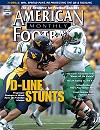AMERICAN FOOTBALL MONTHLY THE #1 RESOURCE FOR FOOTBALL COACHES
Article CategoriesAFM Magazine
|
The Strength Report: Defensive Backsby: Trent GreenerStrength and Conditioning Coordinator, University of Washington © More from this issue My philosophy for training the college football athlete is based upon the physical and mental demands occurring during the course of a normal practice and game. Football is a collision oriented game grounded in the physical skills of blocking, tackling, jumping, running, throwing and kicking. These are skills initiated by the lower body and lend credibility to the maxim of football being played on your feet. These highly synchronized skills are executed with the athlete’s strength, speed, agility and flexibility which thankfully can be developed and improved through training. A high level of conditioning is also a must for players to execute these skills successfully for the duration of a game and a potential 5 month and 13 game season. Finally, a physical development strategy must add....The full article can only be seen by subscribers. Subscribe today!
|
|
|||||||
| HOME |
MAGAZINE |
SUBSCRIBE | ONLINE COLUMNISTS | COACHING VIDEOS |
Copyright 2025, AmericanFootballMonthly.com
All Rights Reserved





